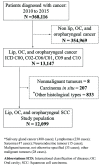Epidemiology and survival outcomes of lip, oral cavity, and oropharyngeal squamous cell carcinoma in a southeast Brazilian population
- PMID: 35368013
- PMCID: PMC9054163
- DOI: 10.4317/medoral.25147
Epidemiology and survival outcomes of lip, oral cavity, and oropharyngeal squamous cell carcinoma in a southeast Brazilian population
Abstract
Background: Lip, oral cavity, and oropharyngeal squamous cell carcinoma (SCC) represent a major health problem in the global scenario. In South America, the highest incidence rates are seen in Brazil. Therefore, the epidemiological and clinical profile and survival outcomes of lip, oral cavity, and oropharyngeal SCC was studied in São Paulo State, Brazil.
Material and methods: The clinicopathological data of 12,099 patients with lip, oral cavity, and oropharyngeal SCC were obtained from hospital cancer registries of the Fundação Oncocentro de São Paulo, Brazil (2010-2015). Survival rates and other analyses were performed using SPSS software.
Results: A clear male predominance was observed, particularly for patients with oropharyngeal SCC (88.3%). The average age of patients was higher for lip cases (65 ± 13.5 years) compared to other sites. The schooling level was low for most patients, especially in lip cases (87.9%). Most of the patients with oral cavity (71.8%) and oropharyngeal (86.3%) SCC had advanced-stage (III-IV) disease. However, the majority of lip cases (83.3%) were at an early stage (I-II). Surgical excision was the main treatment for lip (72%) and oral cavity SCC (23.5%), and chemoradiotherapy was the main treatment for oropharyngeal SCC (40.2%). The 5-year overall survival (OS) for patients with lip, oral cavity, and oropharyngeal SCC were 66.3, 30.9, and 22.6%, respectively. Multivariate analysis revealed that the determinants of OS were different for lip, oral cavity, and oropharyngeal SCC, except for those at the clinical stage, which was an independent predictor for all sites.
Conclusions: OS-independent determinants varied according to the affected site. Oral cavity and oropharyngeal SCC presented worse survival rates than those for lip SCC.
Conflict of interest statement
Conflicts of interest The authors state that there were no conflicts of interest.
Figures



References
-
- Sung H, Ferlay J, Siegel RL, Laversanne M, Soerjomataram I, Jemal A. Global cancer statistics 2020: GLOBOCAN estimates of incidence and mortality worldwide for 36 cancers in 185 countries. CA Cancer J Clin. 2021;71:209–49. - PubMed
-
- De Cicco R, Menezes R de M, Nicolau UR, Pinto CAL, Villa LL, Kowalski LP. Impact of human papillomavirus status on survival and recurrence in a geographic region with a low prevalence of HPV-related cancer: A retrospective cohort study. Head Neck. 2020;42:93–102. - PubMed
-
- Perdomo S, Roa GM, Brennan P, Forman D, Sierra MS. Head and neck cancer burden and preventive measures in Central and South America. Cancer Epidemiol. 2016;44:43–52. - PubMed
MeSH terms
LinkOut - more resources
Full Text Sources
Medical
Research Materials

